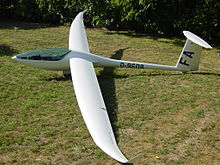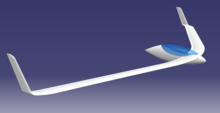Akaflieg Karlsruhe
| Surname | Academic flying group at the Karlsruhe Institute of Technology V. |
|---|---|
| Founded | 1928 (re-established 1951) |
| Place of foundation | Karlsruhe |
| Association headquarters | Karlsruhe |
| Members | approx. 30 (as of 2015) |
| Homepage | www.akaflieg.uni-karlsruhe.de |
The Academic Aviation Group at the Karlsruhe Institute of Technology eV is a student university group at KIT that deals with the design, construction and flying of gliders. She is a member of Idaflieg . The latest aircraft project is a flying wing of the FAI 15 m class , the AK-X.
history
Akaflieg from 1928 to 1933
In the winter semester of 1927/28, a glider pilot group was founded at the suggestion of Karl Töpfer, assistant at the chair for motor vehicles with a teaching position for aircraft technology. This was entered in the register of associations under the name "Academic Fliegergruppe Karlsruhe 1928". The first flight attempts were made with the hang glider “Brigant”, which had been taken over by the disbanded “Glider Flying Group Karlsruhe”. In the period up to 1933 three gliders were built: “Zögling”, “Hol's der Teufel” and “Karlsruhe”.
On May 13, 1933, Akaflieg Karlsruhe was dissolved. The entire device was transferred to the Karlsruhe branch of the German Air Sports Association .
Re-establishment in 1951
After the release of gliding, the Academic Aviation Group Karlsruhe was re-established on May 22, 1951. On the day it was founded, the group already had 78 members. Thanks to the support of numerous friends and sponsors, the Akaflieg aircraft fleet was quickly expanded. In 1954, a performance two-seater Kranich III was acquired and named "Walter". In 1955 a new Doppelraab V6 “Studiosus” and a Bücker Bü 181 Bestmann motorized aircraft were added. A self-made L-Spatz 55 disc completed the Akaflieg fleet.
Work on the AK-1 project began in the mid-1960s . On January 9, 1971 at 12:31 CET , the AK-1 took off on its own for the first time.
The 1970s and early 1980s
In the early 1970s, flight testing of the AK-1 had priority. On October 27, 1973, it was decided to plan the AK-2, a plastic motorized glider . In parallel to the incomplete AK-, Akaflieg Karlsruhe has been involved in the design and construction of flight data computers for gliding since the early 1970s . The electric variometer with speed command sensor AK-3 was built in a small series and expanded as AK-3R to include a final approach computer.
Under the project name AK-4, a data acquisition system for climate measurements over the Upper Rhine with a powered aircraft was developed in cooperation with the Institute for Meteorology and Climate Research .
Akaflieg Karlsruhe from 2000
Akaflieg Karlsruhe has a workshop on the west campus of KIT. The students spend a large number of their 300 hours a year in these rooms.
The AK-8 , a standard class glider and a DG Flugzeugbau DG-1000 with 400-N turbine (AK-9) are in flight testing. The latest aircraft project is the AK-X, a flying wing of the FAI 15 m class. Since the closure of the Karlsruhe-Forchheim airfield, flight operations have been taking place on the newly created glider airfield in Rheinstetten .
Projects
- AK-1
- AK-2
- The aim of the project was to develop a glider with a retractable engine based on the glass wing 604 , in which the engine remains in the fuselage, which was an innovation in the 1970s. Due to disputes within the group and technical difficulties, the project was canceled after 16 years in favor of the AK-5.
- AFK-3
- At the end of the 1980s, the old AFK-2 take-off winch had to be replaced. The motor of the new design AFK-3 acts either on the cable drums or the axle via a transfer case, so that the winch is self-propelled. A cable car can be piggybacked for relocation trips . The winch driver sits in the passenger seat in the cab. The winch functions are controlled electro-hydraulically. In winch training, the instructor can intervene using his own brake and gas pedals if necessary.
- AK-5 and AK-5b
- The AK-5 is a single-seat glider of the standard class in FRP construction. The front part of the fuselage of the middle decker was taken over from the glass wing 604 . The wings were built in the shape of the Falcon , a unique piece built by Hansjörg Stripeeder. The aim was to pass on the existing knowledge about the design and construction of modern gliders to the next generation of Aka pilots. It should also be a construction that can be used in everyday school operations. In addition, it was designed inexpensively in fiberglass construction. The first flight of the AK-5 was on June 1, 1990.
- The AK-5b is a further development of the AK-5 with molded winglets and modified fuselage interior and tail unit. It differs from the AK-5 in particular through a new control mechanism, which makes it easier to fly. The use of new materials makes it a little lighter. The first flight of the AK-5b was in 1996.
- AK-8
- The AK-8 is an FAI standard class glider with an elliptical leading edge of the wing.
- AK-9
- The AK-9 (also DG-1000J) project describes the research into the installation of a 400N turbine in a two-seater glider. The properties of the AMT titanium engine from the Dutch manufacturer Draline were researched in cooperation with the Institute for Thermal Fluid Machines at KIT. The engine was then integrated into Akaflieg's DG Flugzeugbau DG-1000 .
- AK-X
- The AK-X project is the design of a flying wing glider with good-natured flight characteristics and good flight performance . The experiences of the Horten brothers' flying wings and the SB 13 of Akaflieg Braunschweig were included in this project.
The static vibration test of a model on a scale of 1: 2 provided further data for the design of the person-bearing prototype. In 2015 the 1: 2 model was tested in flight.
Web links
Individual evidence
- ↑ Akaflieg Karlsruhe: AK-2 "The Unfinished". Retrieved September 11, 2015 .
- ↑ Akaflieg Karlsruhe: AK-5 "Ardea". Retrieved September 11, 2015 .
- ^ Akaflieg Karlsruhe: AK-9: DG-1000 turbine. Retrieved April 15, 2015 .






